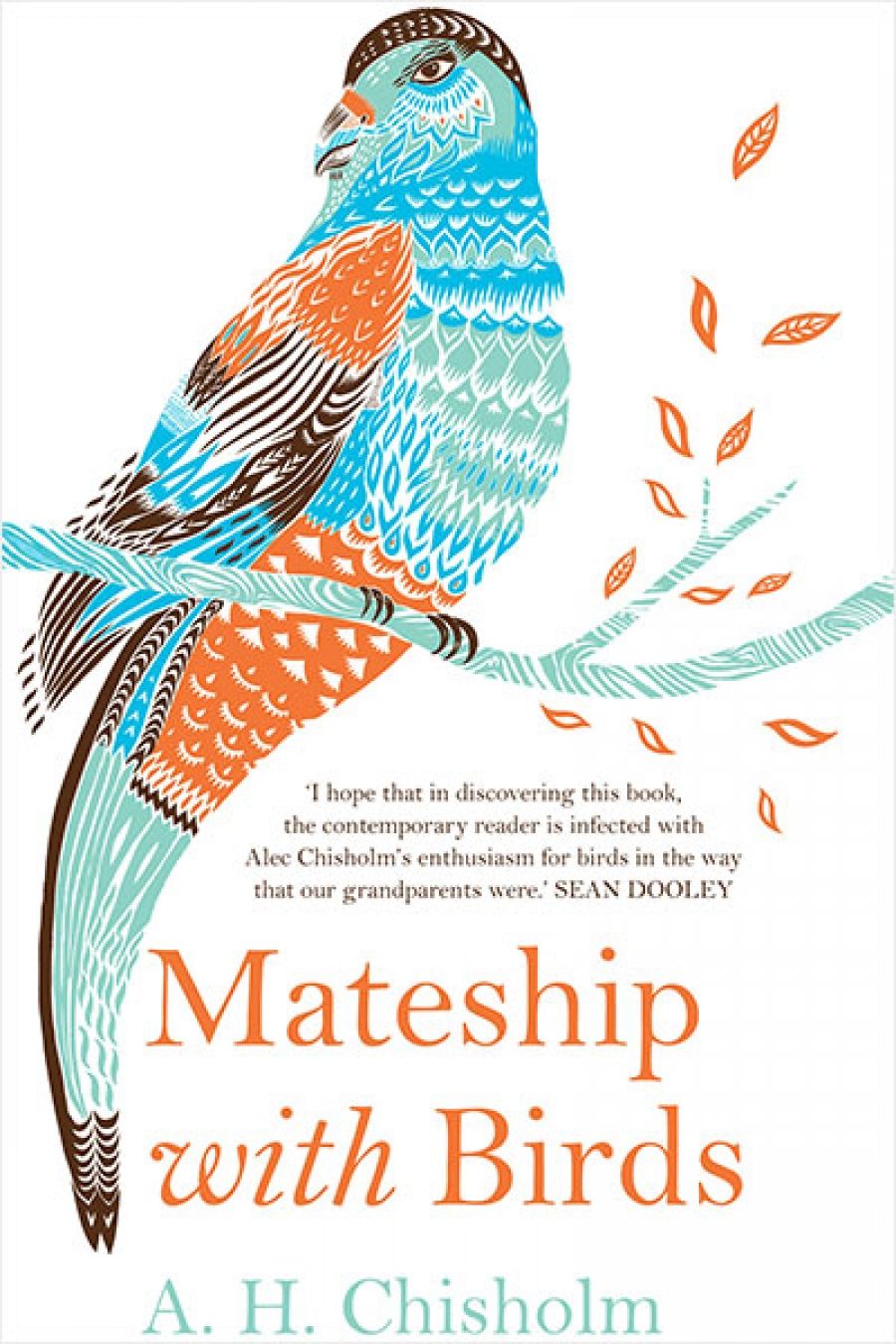
- Free Article: No
- Contents Category: Ornithology
- Custom Article Title: Andrew Fuhrmann reviews 'Mateship with Birds' by A.H. Chisholm
- Review Article: Yes
- Article Title: Call me Ishmaelitish
- Online Only: No
- Custom Highlight Text:
Alec Hugh Chisholm, born in 1890 at Maryborough, is a legendary figure among Australian birders. He was a pioneering member of the Royal Australasian Ornithologists Union, later known as Birds Australia, now BirdLife Australia, and worked tirelessly to facilitate and promote ornithological research. He was a prolific author of journal articles, field notes, prefaces, reflective essays, and popular books on birding.
- Book 1 Title: Mateship with Birds
- Book 1 Biblio: Scribe, $24.95 pb, 199 pp, 9781922070326
Mateship with Birds, first published in 1922, is a cheerful collection of his early essays. Pitched at a general audience, it was a bestseller in its day and secured Chisholm’s reputation as a fluent advocate for his ‘companions of the air’. The book’s subject and chief lesson is the author’s own apparently boundless enthusiasm, a passion that aims by mesmerical music and poetic suggestion to beguile readers from their city enclaves toward the promised arcadia of up-country open spaces.
It is primarily because of this wonder of music and poetry that Mateship is now being republished. It is a worthy choice. While it might not have the full-blown pastoral metaphysics of a Walden, it does share much of the same irresistible fondness for the natural world as Thoreau’s masterpiece:
All the Winter through Jacky of that ilk, the Brown Flycatcher, has been disporting himself, like Lowell’s Blue-Bird, ‘from post to post along the cheerless fence’, or chanting his ‘Jacky-Jacky-Jacky, Sweeter-sweeter-sweeter!’ in the big dry tree by the roadside.
The book is in two parts, the first being ‘A Pageant of Spring’, and a pageant it is, a charming procession of form, colour, and piping music, through August, September, and October. The ‘rising fire of the season’ is conjured in observations and anecdotes, with the whole ornamented from a vast trove of quotations, including Shakespeare, Swinburne, Gray, nursery rhymes, classical mythology, Scotch lullabies, letters from children, ornithological literature, and especially Australian verse.
I use the word ‘charming’ advisedly. Readers may wince at some of Chisholm’s more whimsical devices, as when he suggests that ‘bush-flowers are the smile of the earth, which smile persuades the air to laughter, expressed in the songs of mating birds’, but there is more here that is modern and enduring.
Chisholm’s extravagant anthropomorphism, for instance, anathema to most contemporary science writers, yields images both striking and perceptive, even useful. The Pallid Cuckoo, a brood parasite, nestless and forever harried, becomes the ‘Ishmaelitish Pallid Cuckoo’. There is a similar ‘sophisticated naïveté’ in his involved experiments at representing birdcalls, such as this record of a Clamorous Reed Warbler:
Che, che, che, peet, peet, Georgie, tu-whee, tu-whee, tu-whee, yui, yui, yui, sweet, sweet, tinkle, tinkle, tinkle, wheree, wheree, wheree, cling, cling, cling, wit ter, wit see, now, now, now, witchee, witchee!
This ludic feel for the pure ‘sounds and sweet airs’ of language – of his own, of the birds – is also evident in the patchwork of poetic quotations with which he crowns each vernal jubilation. One of the unexpected pleasures of Mateship is the way its eccentric spirit seems to revivify the now largely disdained talent of poets such as Mackellar, Shaw Neilson, McCrae, Jennings Carmichael, and many others.
The title of Chisholm’s book – if not something of the strong-savoured, rural sensuality of his prose – will already be familiar to many through Carrie Tiffany’s novel Mateship with Birds (2012), in which the protagonist, Harry the dairy farmer, begins authoring a series of bird notes on the family of kookaburras roosting about his farm, notes which soon encompass reflections of a more spiritual nature. One reviewer described them as being ‘like an Elizabeth Bishop poem’. That might be too generous, but it sums up Tiffany’s general thesis that ‘art starts with noticing things’. This is also the secret to Chisholm’s book. Even his wildest lyricising flights are tethered by accurate observation.
The second part, ‘Biographies of Birdland’, contains a number of studies of individual species, loosely grouped around six broad themes. There is a wealth of detail here, much of which will be interesting and encouraging to the beginner. There is plenty also for more experienced birders. We notice the habits and haunts of the Regent Honeyeater, for example, described with casual familiarity. As Sean Dooley writes in his new foreword, ‘today, this stunning woodland bird is down to around 500 individuals in the wild, and [...] appears to be on a downward spiral towards extinction’.
In the final chapter, Chisholm offers a sad preview of this fate in his account of the last days of the Paradise Parrot. Chisholm was among the last to see this spectacular creature, about which it was said, with sad truth, ‘no one can see it without desiring to possess so beautiful and graceful a bird’.
The text is elegantly presented, but assistance in converting the scientific and common names of Chisholm’s day to our own might have been useful. I am sure many older, and some younger, birdwatchers will know that the White-shouldered Caterpillar-eater (Campephega humeralis) is now better known as the White-winged Triller (Lalage tricolor), but there is little in this edition to point curious readers in that direction.
Chisholm’s lyricising imagination is fatigueless throughout, and whatever the book’s faults of fashion, its brief lapses into what now appears an unseemly purple, it is without doubt a book deserving its place in the new catalogue of revived Australian classics presently coming to light.


Comments powered by CComment